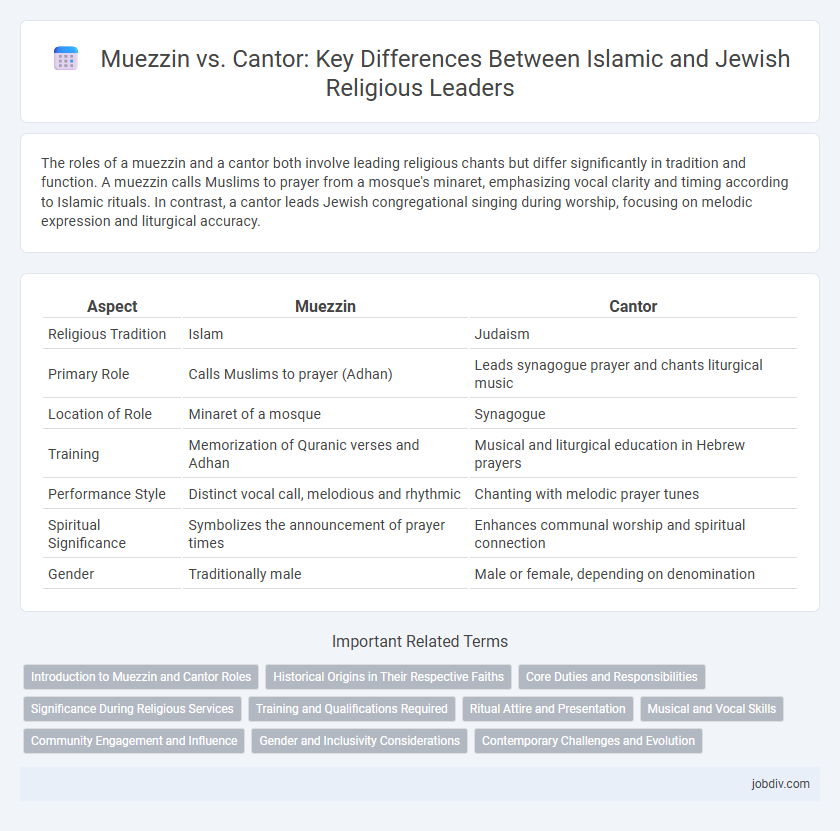The roles of a muezzin and a cantor both involve leading religious chants but differ significantly in tradition and function. A muezzin calls Muslims to prayer from a mosque's minaret, emphasizing vocal clarity and timing according to Islamic rituals. In contrast, a cantor leads Jewish congregational singing during worship, focusing on melodic expression and liturgical accuracy.
Table of Comparison
| Aspect | Muezzin | Cantor |
|---|---|---|
| Religious Tradition | Islam | Judaism |
| Primary Role | Calls Muslims to prayer (Adhan) | Leads synagogue prayer and chants liturgical music |
| Location of Role | Minaret of a mosque | Synagogue |
| Training | Memorization of Quranic verses and Adhan | Musical and liturgical education in Hebrew prayers |
| Performance Style | Distinct vocal call, melodious and rhythmic | Chanting with melodic prayer tunes |
| Spiritual Significance | Symbolizes the announcement of prayer times | Enhances communal worship and spiritual connection |
| Gender | Traditionally male | Male or female, depending on denomination |
Introduction to Muezzin and Cantor Roles
Muezzins serve as the callers to Islamic prayer, traditionally reciting the adhan from mosques to signal the five daily prayer times, emphasizing the importance of rhythm and vocal clarity in their role. Cantors, or hazzans, lead Jewish congregational singing and chant liturgical prayers during services, focusing on melodic execution and spiritual expression within synagogue worship. Both positions hold significant religious functions, playing vital roles in guiding worshippers through auditory cues and sacred music.
Historical Origins in Their Respective Faiths
The Muezzin in Islam originated during the time of Prophet Muhammad, serving the crucial role of calling the faithful to prayer from mosque minarets. In Judaism, the Cantor, or Hazzan, has roots dating back to ancient Temple worship in Jerusalem, guiding congregational singing and prayer. Both roles are deeply embedded in their respective religious traditions, symbolizing spiritual leadership and communal devotion through vocal proclamation.
Core Duties and Responsibilities
Muezzins are responsible for calling Muslims to prayer five times daily, ensuring precise timing and pronunciation according to Islamic tradition. Cantors lead Jewish congregational singing and chant liturgical prayers during synagogue services, preserving musical heritage and enhancing worship experience. Both roles serve as spiritual facilitators, but the Muezzin's duty centers on auditory call to prayer while the Cantor focuses on melodic leadership in religious rituals.
Significance During Religious Services
The Muezzin holds significant religious importance in Islam by calling the faithful to prayer five times daily from the mosque's minaret, symbolizing devotion and unity. The Cantor, or Chazzan, plays a crucial role in Jewish worship by leading prayers and chants, enhancing communal spiritual experience through melodic recitation. Both figures serve as vital spiritual leaders, facilitating religious observance and fostering congregation participation through vocal traditions unique to their faiths.
Training and Qualifications Required
Muezzins undergo specialized training in Quranic recitation (Tajweed) and memorization to deliver the Adhan with precise pronunciation and melodic intonation, often requiring years of dedicated study under qualified Islamic scholars. Cantors, or hazzans, typically receive formal education in Jewish liturgical music and Hebrew language, including voice training and theological studies, often supported by accredited cantorial schools or seminaries. Both roles demand a deep understanding of religious texts and rituals, but the Muezzin's qualifications focus on oral transmission and melodic chanting, whereas the Cantor emphasizes musical interpretation and communal worship leadership.
Ritual Attire and Presentation
The ritual attire of a Muezzin typically includes a traditional robe such as a thobe or jubba, often accompanied by a kufi cap, reflecting Islamic cultural and religious practices. In contrast, a Cantor commonly wears a tallit (prayer shawl) and kippah, symbolizing Jewish liturgical traditions and synagogue customs. Presentation-wise, the Muezzin's role involves calling to prayer from a mosque's minaret or loudspeakers, while the Cantor leads congregational singing and prayers within the synagogue setting.
Musical and Vocal Skills
The Muezzin's vocal skills emphasize a powerful, melodious call to prayer using intricate maqamat scales rooted in Islamic tradition, showcasing precision in pitch and breath control without instrumental accompaniment. The Cantor, or Hazzan, excels in liturgical chanting with complex vocal techniques, including melisma and dynamic modulation, often supported by a choir or musical instruments in synagogue services. Both roles require exceptional musicality and vocal discipline, yet the Muezzin's performance is spontaneous and outside formal worship settings, while the Cantor's is structured and integral to synagogue rituals.
Community Engagement and Influence
The Muezzin, calling the faithful to prayer five times daily in Islam, fosters unity and discipline within the Muslim community through a powerful auditory ritual. The Cantor, or Hazzan, leads Jewish congregational singing and prayer, enhancing spiritual connection and communal participation during synagogue services. Both roles serve as pivotal anchors of religious identity, deeply influencing worshippers' sense of belonging and collective faith experience.
Gender and Inclusivity Considerations
The roles of Muezzin in Islam and Cantor in Judaism traditionally have been male-dominated due to religious and cultural norms. Recent movements within both faiths advocate for greater gender inclusivity, with female cantors becoming more common in Reform and Conservative Jewish communities, while some Muslim communities explore female muezzins in non-traditional contexts. These shifts reflect broader trends toward gender equality and inclusivity within religious practices, challenging historical gender restrictions in sacred chanting and prayer leadership.
Contemporary Challenges and Evolution
Muezzins and cantors face contemporary challenges including maintaining relevance in increasingly secular societies and adapting to digital technologies for broadcasted prayers. Both roles evolve as they balance traditional responsibilities with modern expectations for inclusivity and enhanced community engagement. Technological advancements like mobile apps and live streaming reshape how calls to prayer and liturgical chants reach global audiences today.
Muezzin vs Cantor Infographic

 jobdiv.com
jobdiv.com